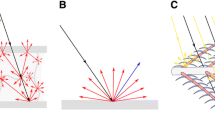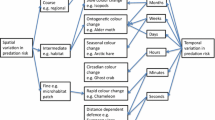Abstract
Barred plumage is common among bird species. It is often interpreted as a form of crypsis because pigmentation patterns are less detectable against heterogeneous backgrounds. However, it has also been suggested that barred plumage could signal plumage condition, because it makes irregularities in the plumage perceptually salient. Little empirical work exists on the function of barred plumage, in part because we lack a way for quantifying the regularity of the pattern. Here, we present a method to analyze digital photographs of barred plumage and quantify the regularity of its pattern, and also provide software to perform the analysis. Using museum skins of five avian species, we tested under which conditions the method reliably captures differences among conspecific males in the regularity of their barred pattern. We found that measurements of regularity were highly repeatable when lighting conditions were standardized, unlike under variable illumination, and a relatively large area of barred plumage was analyzed, rather than small and non-representative subsections of plumage. The range of conditions under which the method performs well makes it adequate for use in the field, and we hope that it fosters research on the function of barred plumage as a communication signal.





Similar content being viewed by others
References
Bortolotti GE (2006) Natural selection and colouration. In: Hill GE, McGraw KJ (eds) Bird colouration: function and evolution, vol 2. Harvard University Press, Cambridge, pp 3–35
Bortolotti GE, Blas J, Negro JJ, Tella L (2006) A complex plumage pattern as an honest social signal. Anim Behav 72:423–430
Bradbury JW, Vehrencamp SL (1998) Principles of animal communication. Sinauer, Sunderland
Davies NB, Welbergen JA (2008) Cuckoo–hawk mimicry? An experimental test. Proc R Soc Lond B 275:1817–1822
Dunning JB (2008) CRC handbook of avian body masses. Taylor & Francis, Boca Raton
Ferguson-Lees J, Christie DA (2001) Raptors of the world. Helm, London
Herremans M, Louette M (2000) A partial post-juvenile moult and transitional plumage in the Shikra (Accipiter badius) and Grey frog hawk (Accipiter soloensis). J Rapt Res 34:249–261
Kenward B, Wachtmeister CA, Ghirlanda S, Enquist M (2004) Spots and stripes: the evolution of repetition in visual signal form. J Theor Biol 230:407–419
Krüger O, Davies NB, Sorenson MD (2007) The evolution of sexual dimorphism in parasitic cuckoos: sexual selection or coevolution? Proc R Soc Lond B 274:1553–1560
Lessels CM, Boag PT (1986) Unrepeatable repeatabilities: a common mistake. Auk 104:116–121
Otsu N (1979) A threshold selection method from gray-level histograms. IEEE Trans Syst Man Cybern 9:62–66
Riegner MF (2008) Parallel evolution of plumage pattern and coloration in birds: implications for defining avian morphospace. Condor 110:559–614
Stevens M, Yule DH, Ruxton GD (2008) Dazzle coloration and prey movement. Proc R Soc Lond B 275:2639–2643
Swaddle JP (2003) Fluctuating asymmetry, animal behaviour, and evolution. Adv Study Behav 32:169–205
Swaddle JP, Cuthill IC (1994) Female zebra finches prefer males with symmetric chest plumage. Proc R Soc Lond B 258:267–271
Swaddle JP, Douglas RA, Page LC, Frame AM, Long VA (2008) A test of receiver perceptual performance: European starlings’ ability to detect asymmetry in a naturalistic trait. Anim Behav 76:487–495
Acknowledgments
We thank Wayne Longmore for assistance with accessing Museum Victoria specimens, and Paulo Peixoto, António Marques and Pablo Silva for discussions and suggestions on programming. Two anonymous reviewers gave constructive suggestions that improved this article. This research was supported by a University of Melbourne ECR grant to GCC.
Author information
Authors and Affiliations
Corresponding author
Additional information
Communicated by: I. Cuthill
Rights and permissions
About this article
Cite this article
Gluckman, TL., Cardoso, G.C. A method to quantify the regularity of barred plumage patterns. Behav Ecol Sociobiol 63, 1837–1844 (2009). https://doi.org/10.1007/s00265-009-0823-5
Received:
Revised:
Accepted:
Published:
Issue Date:
DOI: https://doi.org/10.1007/s00265-009-0823-5




